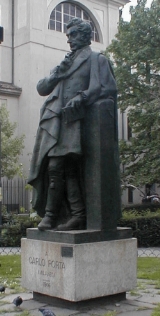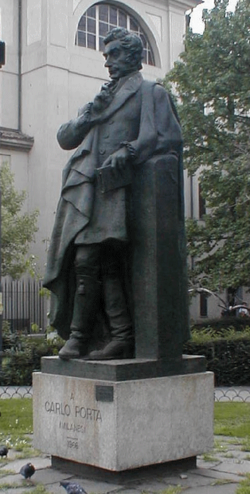
Carlo Porta
Encyclopedia

Milanese
Milanese is the central variety of the Western Lombard language spoken in the city and province of Milan....
(the central dialect of the Western Lombard language).
Biography
Porta was born in MilanMilan
Milan is the second-largest city in Italy and the capital city of the region of Lombardy and of the province of Milan. The city proper has a population of about 1.3 million, while its urban area, roughly coinciding with its administrative province and the bordering Province of Monza and Brianza ,...
to Giuseppe Porta and Violante Gottieri, a merchant family. He studied in Monza
Monza
Monza is a city and comune on the river Lambro, a tributary of the Po, in the Lombardy region of Italy some 15 km north-northeast of Milan. It is the capital of the Province of Monza and Brianza. It is best known for its Grand Prix motor racing circuit, the Autodromo Nazionale Monza.On June...
until 1792 and then in the Seminario of Milan. In 1796, the Napoleonic Wars
Napoleonic Wars
The Napoleonic Wars were a series of wars declared against Napoleon's French Empire by opposing coalitions that ran from 1803 to 1815. As a continuation of the wars sparked by the French Revolution of 1789, they revolutionised European armies and played out on an unprecedented scale, mainly due to...
pushed Porta to find a job in Venice
Venice
Venice is a city in northern Italy which is renowned for the beauty of its setting, its architecture and its artworks. It is the capital of the Veneto region...
(where one of his brothers lived) and he remained there until 1799.
From 1804 until his death, Porta worked as clergyman. In 1806, he married to Vincenza Prevosti.
He died in Milan in January 1821 from an attack of gout
Gout
Gout is a medical condition usually characterized by recurrent attacks of acute inflammatory arthritis—a red, tender, hot, swollen joint. The metatarsal-phalangeal joint at the base of the big toe is the most commonly affected . However, it may also present as tophi, kidney stones, or urate...
and was buried in the Church of San Gregorio. His tomb was subsequently lost.
Works
Porta began to write poems in 1790, although few of them were published before 1810. In 1804-1805 he worked at a Milanese translation of the Divine Comedy, which he, however, left unfinished. In these years the progressive group that formed round him and called themselves the "Camerletta Portiana" included Giuseppe BossiGiuseppe Bossi
Giuseppe Bossi was an Italian painter, arts administrator and writer on art. He ranks among the foremost figures of Neoclassical culture in Lombardy, along with Ugo Foscolo, Giuseppe Parini, Andrea Appiani or Manzoni....
, who painted a group portrait of four Amici della Camerletta Portiana.
In 1810, Brindisi de Meneghin all'Ostaria (written for Napoleon's return in Milan) was published. This was one of many works by Porta featuring Meneghino
Meneghino
Meneghino is a traditional character of the Italian commedia dell'arte, associated to the city of Milan. As such, it also plays a major role in the Milanese celebrations of Carnival and in local marionette traditional shows.It is uncertain whether "Meneghino" is just a diminutive form of...
(the traditional commedia dell'arte
Commedia dell'arte
Commedia dell'arte is a form of theatre characterized by masked "types" which began in Italy in the 16th century, and was responsible for the advent of the actress and improvised performances based on sketches or scenarios. The closest translation of the name is "comedy of craft"; it is shortened...
character representing Milan). His best season began two years later, with Desgrazzi de Giovannin Bongee ("Troubles of Johnny Bolgeri").
His works can be divided into three categories: works against superstition and religious hypocrisy, descriptions of vivid Milanese popular characters, and political works. The first one includes Fraa Zenever ("Brother Juniper", 1813), On Miracol ("A Miracle", 1813), Fraa Diodatt ("Brother Adeodato", 1814), La mia povera nonna la gh'aveva ("My dead granny had...", 1810). His political satires were mainly sonnets, such as Paracar che scappee de Lombardia ("Scarecrows [literally 'milestones', referred to Frenchmen] who are escaping from Lombardy", 1814), E daj con sto chez-nous, ma sanguanon ("And go on with this 'chez-nous', but bloody Heaven...", a satire about French, 1811), Marcanagg i politegh secca ball (1815, "Goddam ballbreaker politicians"), Quand vedessev on pubblegh funzionari ("When I'd see a public officer...", 1812). Porta satirized the upcoming new Milanese aristocracy, too, in La nomina del cappellan (1819, "The chaplain's appointment"), making a parody of the episode of the "vergine cuccia" ("virgin pet-pup") in Il Giorno (Il Mezzogiorno), by Giuseppe Parini
Giuseppe Parini
Giuseppe Parini was an Italian Enlightenment satirist and poet of the neoclassic period.-Biography:Parini was born in Bosisio in Brianza, Lombardy...
(a satire itself).
His best works are probably those portraying the Milanese popular life, with the collections Olter desgrazzi de Giovannin Bongee ("Other Troubles of Johnny Bolgeri", 1814), El lament del Marchionn di gamb avert ("The Lament of Melchior the Crippled", 1816) and what is generally considered his masterwork, La Ninetta del Verzee ("Little Nina, from Greens Market", 1815), a meaningful and heartbreaking monologue/confession of a prostitute. In 1816 Porta joined the Romantic literarian movement (Sonettin col covon, "Little sonnet, with a big tail"), obviously in his own way.
See also
- Insubric literature

